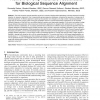758 search results - page 68 / 152 » Coding Exon Detection Using Comparative Sequences |
BMCBI
2007
13 years 10 months ago
2007
Background: False occurrences of functional motifs in protein sequences can be considered as random events due solely to the sequence composition of a proteome. Here we use a nume...
BMCBI
2008
13 years 10 months ago
2008
Background: Modern proteomes evolved by modification of pre-existing ones. It is extremely important to comparative biology that related proteins be identified as members of the s...
BMCBI
2010
13 years 10 months ago
2010
Background: While most multiple sequence alignment programs expect that all or most of their input is known to be homologous, and penalise insertions and deletions, this is not a ...
TC
2010
13 years 8 months ago
2010
—The most pervasive compute operation carried out in almost all bioinformatics applications is pairwise sequence homology detection (or sequence alignment). Due to exponentially ...
BMCBI
2007
13 years 10 months ago
2007
Background: This work addresses the problem of detecting conserved transcription factor binding sites and in general regulatory regions through the analysis of sequences from homo...


